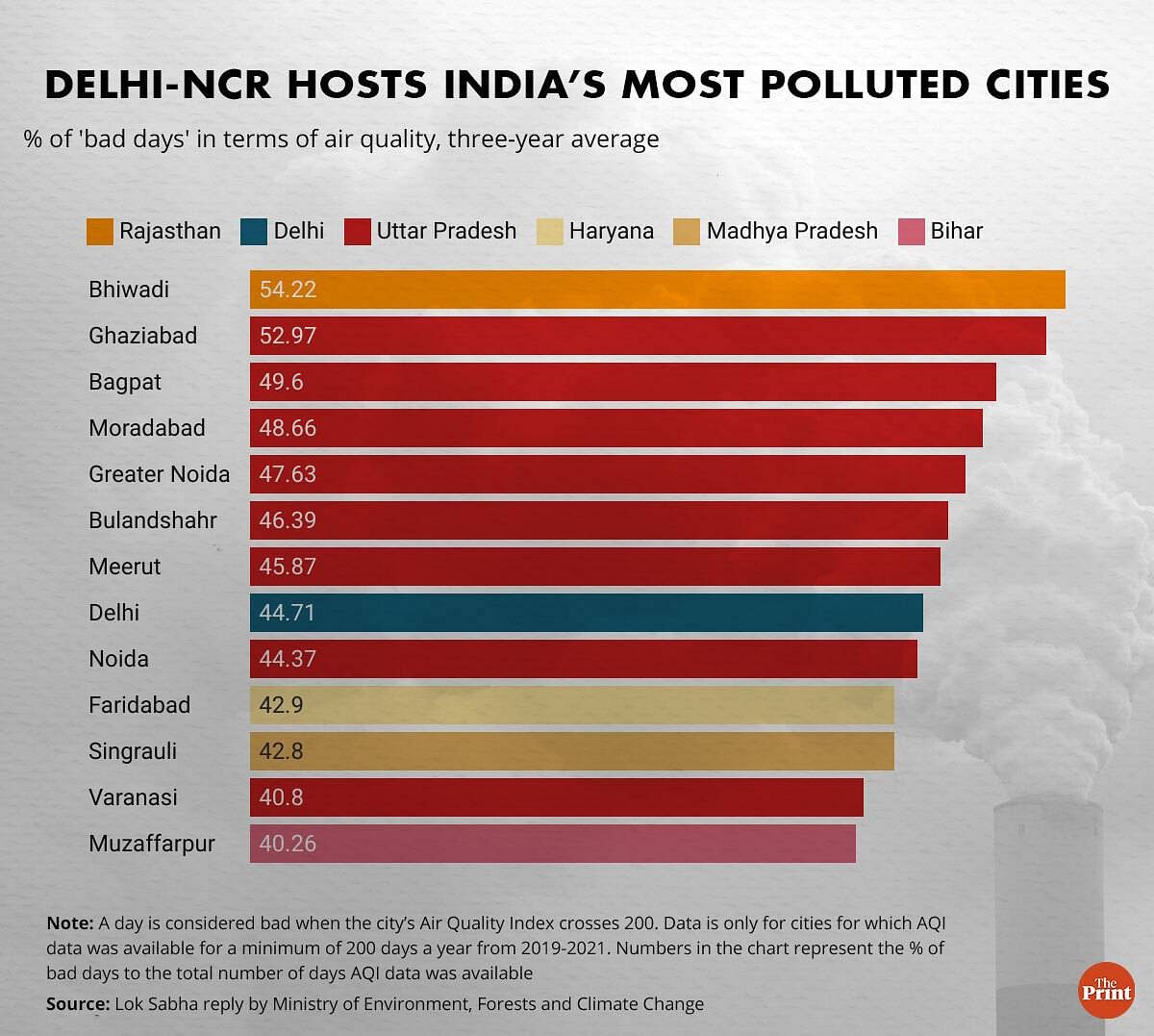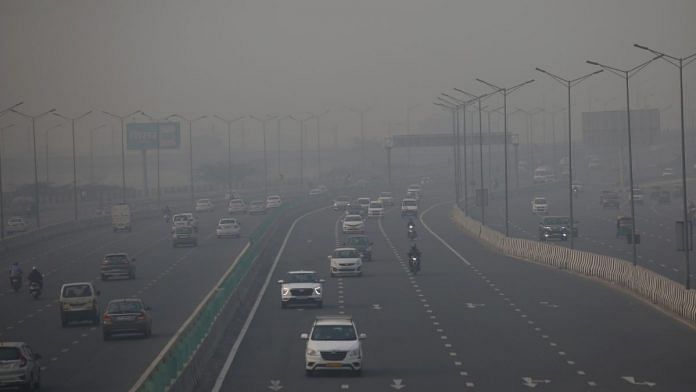New Delhi: Over the past few years, it has become an annual ritual for pollution in Delhi-NCR to make headlines in the winters, which usually last two-three months. However, data released by the Ministry of Environment, Forest and Climate Change (MoEFCC) shows that the National Capital Region (NCR) maintains poor air quality for at least half the time in a year.
In a response to a Lok Sabha question raised by Jaskaur Meena, the Bharatiya Janata Party (BJP) MP for Dausa, Rajasthan, the ministry gave a list of 160 Indian cities along with the number of ‘good’ and ‘bad’ days they faced in terms of pollution.
In its response, the ministry categorised the ‘good’ and ‘bad’ days based on the average daily Air Quality Index (AQI) a city reported over three years — 2019 to 2021. An AQI of over 200 would mean a ‘bad day’, below 200 a ‘good day’.
For a lot of cities, the data isn’t available for many days in a year. So, ThePrint took the data for cities which reported any level of AQI for a minimum of 200 days in a year, and calculated the share of bad days observed out of the total observed days. The final result is the average percentage of bad days faced by a city.
Of the 13 Indian cities where more than 40 per cent of the year consisted of ‘bad’ days, nine were situated within the Delhi-NCR region — Delhi NCT, Bhiwadi, Ghaziabad, Noida, Greater Noida, Faridabad, Bulandshahr, Bagpat, and Meerut.

On average, the National Capital Territory of Delhi reported bad quality air for nearly 45 per cent of the days each year between 2019 and 2021.
Another trend that emerged from the ministry’s data was that the cities with the highest number of bad days are located in the northern part of India.
While the government has cited a list of measures being taken to alleviate the pollution problem in its response, geographical features are also a reason so many north Indian cities remain polluted, according to a report published in 2018 in the environmental advocacy group Centre for Science and Environment’s Down to Earth magazine.
However, Sunil Dahiya, an analyst at the Centre for Research on Energy and Clean Air, a thinktank promoting research on clean energy and reducing air pollution, told ThePrint that “geographical features and meteorological conditions may only contribute to a slight build-up of air pollution levels”.
“We have to realise that most of the air pollution comes from combustion sources. Hence the ideal way to achieve clean air would be to reduce fossil fuel consumption and associated emissions through a shift to better alternatives or efficient pollution control technology adoption,” he said.
Also read: Covid piggybacking on soot? Researchers link stubble burning to Delhi’s 3rd wave in Nov 2020
Pollution mostly a north Indian problem
Bhiwadi, an industrial town in the northern part of Rajasthan, is the country’s most polluted city. On average, the residents breathe bad air for more than 54 per cent of the days in a year.
In 2019, Bhiwadi had 192 bad days as opposed to 132 good ones. In 2020, when the Covid-induced lockdown restricted movement and industrial activity, the city saw 192 good days and 154 bad days. However, as normality returned, so did the pollution. In 2021, the city had 213 bad days and only 142 good days — meaning, in almost every two out of three days, people in Bhiwadi were forced to breathe in bad air.
Bhiwadi was followed by Ghaziabad in Uttar Pradesh where ‘bad days’ made up 53 per cent of a year on an average. Moreover, in Bagpat, Moradabad, Greater Noida, Bulandshahr and Meerut in Western UP, almost every second day is a bad air day.
In Noida, Delhi’s eastern neighbour, 44 per cent of the days in a year are bad on average, followed by Faridabad in Haryana, Singrauli in Madhya Pradesh, Varanasi in UP and Muzaffarpur in Bihar.
Apart from the ministry’s findings, the World Health Organization’s estimates, too, had shown that in 2022, 14 of the world’s 20 most-polluted cities were situated in North India — with Bhiwadi topping the list.
According to the Down to Earth report, North India is largely landlocked, contains large deposits of ‘loose alluvial soils’ that lets dust particles flow freely in the air, and faces winters. All these factors make North India distinct from the south, as far as pollution is concerned.
“However, the difference in geographical features in northern and southern India should not become an excuse to not work harder on improving air quality,” said Dahiya, adding that India’s policy on environment is not driven by emission-reduction goals — something that has failed its policies, although they look good on paper otherwise, he feels.
“If the governments are really serious about reducing pollution, they must set emission caps and reduction targets first. For this purpose, we need studies to establish which sector is contributing how much to the total air pollution, which were supposed to be completed for 132 cities by 2021 but are still far from being completed under the National Clean Air Programme (NCAP). Based on these source-apportionment studies, the government should decide emission caps,” he said.
“The government should also decide by how much they want to reduce pollutant levels and how to achieve it. Whether it comes by reducing vehicles, or investing in emission reducing technology, that has to be backed by research, but it has to start with at least a quantifiable goal,” Dahiya added.
South India sees more ‘good days’
Southern India does much better in air quality. Hyderabad and Bengaluru have never reported a day with an AQI average of over 200 in the past three years — they haven’t seen a ‘bad day’ so far.
Kerala’s capital Thiruvananthapuram reported only one bad air quality day in the past three years, as did Mizoram’s capital Aizawl. Gujarat’s capital Gandhinagar reported only two bad air quality days.
(Edited by Zinnia Ray Chaudhuri)
Also read: Hue & cry over stubble burning baseless: SC pulls up Centre, states on Delhi pollution



